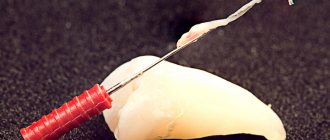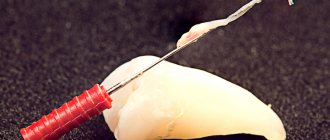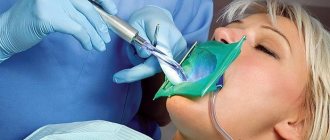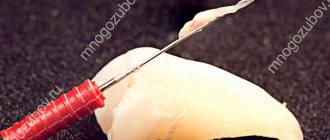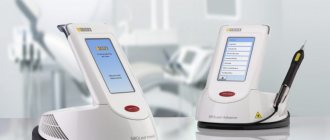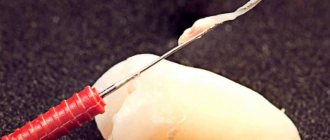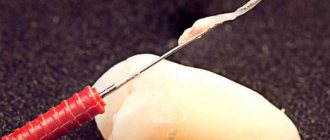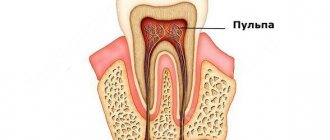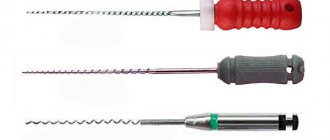Painless removal of a nerve from a tooth: how it goes and consequences
Many people are familiar with the procedure of removing a nerve from a tooth, which was accompanied by the mandatory placement of arsenic. Previously, this method took several days, during which the substance killed the nerve, after which the doctor removed the pulp and installed a filling or crown. Modern methods make it possible not to resort to arsenic, using more effective and painless methods. The pulp or neurovascular bundle performs important functions; it nourishes and protects tooth tissue from infection. Without it, the enamel changes color, hard tissues are destroyed faster, but in some situations, removal of the nerve is necessary.
What to do if you have severe pain?
To relieve pain before visiting the dentist, you can use one of the following:
- To remove the sour taste after installing arsenic, you need to rinse your mouth with a soda solution. This remedy will remove the unpleasant sensation and prevent burns to the oral mucosa if there are residues of the substance there.
- A glass of milk will help relieve pain and remove toxins from the body. Proteins neutralize the effects of arsenic without interfering with its main function.
- For severe pain, you can take Nurofen, ibuprofen or other painkillers.
If there are no signs of inflammation, severe pain does not go away for several days and painkillers do not help, you need to remove the cause - arsenic paste. It's better if a doctor does it. But when a visit to the dentist is not possible, you can carry out the procedure yourself.
- Prepare a needle and tweezers.
- Wash your hands thoroughly and sterilize instruments with alcohol.
- Carry out all manipulations in front of a mirror.
- Using a needle, crumble the temporary filling and use tweezers to pull out the entire contents.
- Prepare a warm solution of water with soda and a few drops of iodine, rinse the mouth.
- Pay special attention to the diseased tooth.
- Prepare a sterile cotton swab and cover the filling site with it.
- Change your tampon and rinse after every meal.
- Visit your dentist as soon as possible.
Causes of dental pulp damage
The dentist is often visited because of caries - damage and destruction of enamel, which at the initial stage causes aesthetic discomfort.
Important: if the disease is started, the process affects the deeper layers of the tooth and pulpitis develops, that is, the neurovascular bundle becomes inflamed.
Pathologies arise due to the rapid proliferation of microbes, but in addition, the pulp can be damaged for the following reasons:
- gum disease, in which the neck of the tooth is exposed, the bone tissue is destroyed and harmful bacteria penetrate inside;
- trauma, as a result of which part of the tooth can break off, and then microbes enter the resulting cavity;
- mistake by the dentist who installed the filling or crown. If some actions were incorrect, then the nerve will make itself felt after a while.
These are the main causes of pulp damage. The symptoms of this condition will be acute. The pulp will begin to react to cold, hot, too spicy, sweet foods. Removing the nerve in such situations is a necessity, despite the fact that minerals and nutrients will stop flowing to the tooth.
Why do you need to remove the pulp?
We talked about the main reasons why nerve inflammation occurs, but most often pulpitis becomes a consequence of advanced caries. Therefore, it is very important to visit a dentist, even if nothing bothers you. The decision to remove the pulp is made in the following situations:
- pulpitis has passed into the stage of periodontitis, when inflammation affects the whole complex of connective tissue in the tooth;
- large area of carious lesion;
- the infection spreads through the apex of the tooth root;
- the appearance of unbearable, prolonged pain;
- spread of infection under an artificial crown;
- consequences of improper treatment.
The nerve can be removed either completely or partially, it all depends on the degree of tissue damage. Depulpation will prevent the spread of the inflammatory process under the crown and preserve the natural tooth, which is a priority for endodontic therapy.
How does the pulp removal process work?
We mentioned the method using arsenic at the very beginning. Some dentists still use it. The disadvantages of this treatment include its duration and pain. Before administering arsenic, the doctor must widen the root canal and place the substance into it. He then seals the area with a temporary filling. After two days, the arsenic kills the nerve, then the dentist cleans the substance from the tooth cavity and removes the pulp.
Important! Arsenic should not remain longer than expected in the oral cavity, as it is a poison and can be destructive to tissue.
There are more modern ways of performing the procedure, which are both safer and more painless. Before any action, an x-ray is required, which shows the vitality of the pulp, the length of the canal and other features.
Pulp removal is carried out using the vital and devital method. The first option is used for patients of any age. Its stages are as follows:
- the tooth is exposed;
- the pulp is removed with a special tool - a pulp extractor;
- a filling is installed.
In some situations it may be temporary and after a few days it changes to permanent.
Note: all stages of treatment are performed under anesthesia, so they will not be painful or uncomfortable for the patient.
The devital method is similar to what was used ten or more years ago, only instead of arsenic, a non-toxic substance is installed in the tooth cavity. The main method of pulp removal in modern dentistry is the vital method, when in just 1 visit to the doctor you can undergo complete painless dental treatment.
Important: temporary pain after a dental procedure is considered normal, as tissue intervention has occurred. If severe pain does not go away within 3 days, you should consult a doctor.
Stages of treatment
First of all, the patient is sent for radiography. Diagnostics allows you to determine how many roots a tooth has and choose the most appropriate method of treating the pathology. The following describes the algorithm of actions for removing pulp in one session.
- Anesthesia. First, the injection site is treated with a special agent, after which an anesthetic is administered and left for about 5–15 minutes.
- Preparing the tooth for depulpation. To extract the pulp, it is necessary to provide access to it. To do this, the doctor opens the crown part of the tooth and then removes all affected tissue.
- Removal of the dental nerve. For these purposes, special instruments are used that quickly remove pulp from both the coronal and root parts.
- Installation of a seal. Depending on the location of the tooth, certain filling materials are used for filling - composites, dental cement, etc. Sometimes the doctor will place a temporary filling to ensure that the removal was completed correctly. In this case, a second visit will be required, during which the condition of the tooth is assessed, the temporary filling is removed, and then a permanent one is installed.
With complete removal, the pulp is removed from the coronal and root parts. If the inflammation has affected only the top of the tooth, partial depulpation is performed. In this case, only the coronal part is cut off, and the pulp in the area of the root system remains intact and fully retains its functions.
To make an appointment, call us at the phone number listed on the website. The specialist will answer all your questions and suggest the most convenient time to visit the doctor.
In what situations should a nerve not be removed?
We are talking not only about contraindications, but also about cases in which the pulp can be preserved. The procedure is not performed if the patient has:
- any infectious disease;
- one of the forms of stomatitis;
- psychoemotional disorders;
- acute pathologies of the heart and blood vessels;
- unsatisfactory condition of the oral cavity with suppuration and inflammation.
The nerve is preserved if it is not subject to inflammation due to caries or other pathologies and injuries. The dentist’s task is to save the pulp and remove it only in case of emergency.
Important: you cannot endure a toothache and hope that the pain in your nerve will stop. Inflammation can become chronic and show almost no effect, but any provoking factor will affect the development of a purulent abscess. In this case, the minimal consequence will be tooth loss, and the possible consequence will be the spread of infection to other tissues.
Why does a tooth hurt with arsenic?
Usually a patient comes to the doctor already with a toothache. After the application of arsenic, the process of death of nerve cells begins, which is painful. In addition to the poison, arsenic-based dental paste contains painkillers: Lidocaine, Novocaine Dicaine. Therefore, even before the nerve is killed, pain is reduced. But this does not always happen. After applying arsenic, the tooth may continue to hurt for a number of reasons:
- High sensitivity.
- Insufficient dose of arsenic in the paste.
- Untimely removal of fillings and arsenic from the dental canal.
- An advanced case of illness. In this situation, arsenic begins to act only on the third day after installation.
- Inflammation of dental tissues and the occurrence of periodontitis due to this. The diagnosis is confirmed by swelling of the tooth, high temperature and the development of an abscess.
- Individual intolerance to arsenic or paste components.
- Allergic reaction.
- An excessive dose of arsenic in the drug and, as a consequence, necrosis of bone tissue.
- Inflammation and pain due to severe toxicity of the substance.
- Irritation of dental tissues.
- Insensitivity to anesthetics contained in arsenic paste.
Read also: Toothache: what to do at home
Irritation of dental tissues
Arsenic is a very strong and toxic substance.
When it comes into contact with healthy tissue, it causes irritation. Until the nerve is completely killed, the pain will not go away.
Sometimes the poison penetrates into areas where the dentist did not plan for its impact. This occurs if the tooth cavity is opened too much and the substance passes through the canals into the periodontal area, causing irritation. The same thing happens when the channel is too wide.
In itself, irritation of dental tissues by arsenic is natural and, if the substance is removed in a timely manner, does not cause much harm.
The main symptoms of this disease are severe, increasing throbbing pain and mild tooth mobility. In this case, you need to consult a doctor.
Inflammatory process
In addition to the usual discomfort, arsenic can cause inflammation.
This process is characterized by symptoms such as swelling of the gums, purulent discharge, and increased body temperature. To avoid such consequences, it is important to correctly calculate the dose of the drug.
An overdose will cause intoxication and, as a result, inflammation.
If the concentration of arsenic is not sufficient, its action will be ineffective and inflammation of the nerve will occur. In both cases, you will have to visit the dentist and replace the drug.
Consequences of nerve removal
If the treatment was carried out by a professional and experienced dentist, then apart from slight pain the patient will not be bothered by anything. Otherwise, there may be such complications:
- a fragment of the instrument remains in the dental canal;
- the nerve was partially removed;
- incorrect or poor-quality filling of the canal;
- mechanical damage to the root or wall;
- rapid darkening of the enamel;
- suppuration due to poor disinfection.
Important! Depulpation at the Crystal clinic is carried out with the minimum possible complications, since all procedures are carried out by certified doctors with extensive experience using high-tech equipment and tools.
After depulpation, it is recommended not to eat for 2-3 hours, not to eat cold, hot, hard or other foods that irritate the mucous membrane. Your doctor will tell you in more detail about the necessary actions after removing the nerve.
